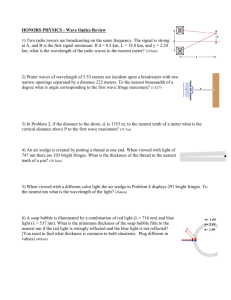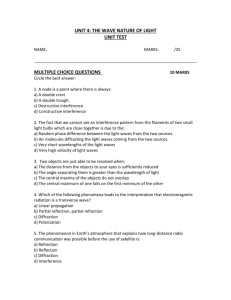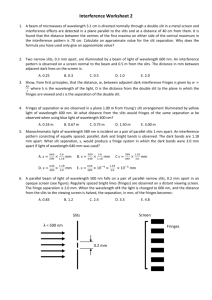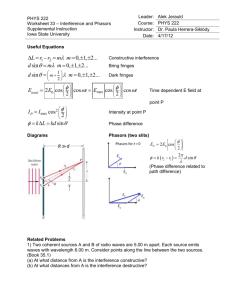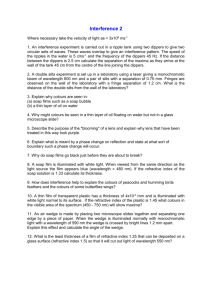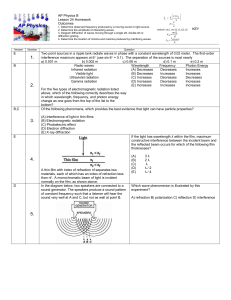AP Physics Problems -- Waves and Light
advertisement
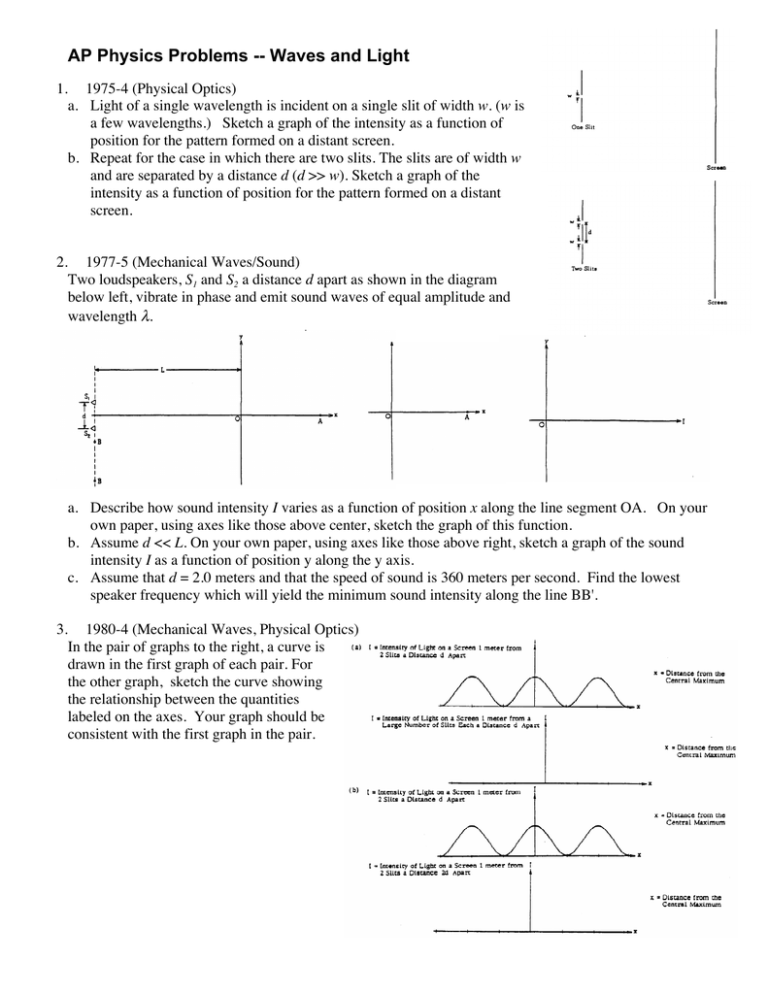
AP Physics Problems -- Waves and Light 1. 1975-4 (Physical Optics) a. Light of a single wavelength is incident on a single slit of width w. (w is a few wavelengths.) Sketch a graph of the intensity as a function of position for the pattern formed on a distant screen. b. Repeat for the case in which there are two slits. The slits are of width w and are separated by a distance d (d >> w). Sketch a graph of the intensity as a function of position for the pattern formed on a distant screen. 2. 1977-5 (Mechanical Waves/Sound) Two loudspeakers, S1 and S2 a distance d apart as shown in the diagram below left, vibrate in phase and emit sound waves of equal amplitude and wavelength λ. a. Describe how sound intensity I varies as a function of position x along the line segment OA. On your own paper, using axes like those above center, sketch the graph of this function. b. Assume d << L. On your own paper, using axes like those above right, sketch a graph of the sound intensity I as a function of position y along the y axis. c. Assume that d = 2.0 meters and that the speed of sound is 360 meters per second. Find the lowest speaker frequency which will yield the minimum sound intensity along the line BB'. 3. 1980-4 (Mechanical Waves, Physical Optics) In the pair of graphs to the right, a curve is drawn in the first graph of each pair. For the other graph, sketch the curve showing the relationship between the quantities labeled on the axes. Your graph should be consistent with the first graph in the pair. 4. 1984-5 (Physical Optics) The surface of a glass plate (index of refraction n3 = 1.50) is coated with a transparent thin film (index of refraction n2 = 1.25). A beam of monochromatic light of wavelength 6.0 × 10-7 m traveling in air (index of refraction n1 = 1.00) is incident normally on surface S1 as shown above. The beam is partially transmitted and partially reflected. a. Calculate the frequency of the light. b. Calculate the wavelength of the light in the thin film. The beam of light in the film is then partially reflected and partially transmitted at surface S2. c. Calculate the minimum thickness d1 of the film such that the resultant intensity of the light reflected back into the air is a minimum. d. Calculate the minimum nonzero thickness d2 of the film such that the resultant intensity of the light reflected back into the air is a maximum. 5. 1985-5 (Physical Optics, Geometric Optics) Light of wavelength 5.0 × 10-7 m in air is incident normally (perpendicularly) on a double slit. The distance between the slits is 4.0 × 10-4 m, and the width of each slit is negligible. Bright and dark fringes are observed on a screen 2.0 m away from the slits. a. Calculate the distance between two adjacent bright fringes on the screen. The entire double-slit apparatus, including the slits and the screen, is submerged in water, which has an index of refraction 1.3. b. Determine each of the following for this light in water. i. The wavelength ii. The frequency c. State whether the distance between the fringes on the screen increases, decreases, or remains the same. Justify your answer. 1990-6 (Physical Optics) A beam of light from a light source on the bottom of a swimming pool 3.0 m deep strikes the surface of the water 2.0 m to the left of the light source, as shown to the right. The index of refraction of the water in the pool is 1.33. a. What angle does the reflected ray make with the normal to the surface? 6. b. What angle does the emerging ray make with the normal to the surface? c. What is the minimum depth of water for which the light that strikes the surface of the water 2.0 meters to the left of the light source will be refracted into the air? In one section of the pool, there is a thin film of oil on the surface of the water. The thickness of the film is 1.0 × 10-7 m and the index of refraction of the oil is 1.5. The light source is now held in the air and illuminates the film at normal incidence, as shown above. d. At which of the interfaces (air-oil and oil-water), if either, does the light undergo a 180° phase change upon reflection? e. For what wavelengths in the visible spectrum will the intensity be a maximum in the reflected beam? 1991-6 (Physical Optics) Light consisting of two wavelengths, λa = 4.4 × 10-7 m and λb = 5.5 × 10-7 m, is incident normally on a barrier with two slits separated by a distance d. The intensity distribution is measured along a plane that is a distance L = 0.85 m from the slits as shown above. The movable detector contains a photoelectric cell whose position y is measured from the central maximum. The first-order maximum for the longer wavelength λb occurs at y = 1.2 x 10-2 m. a. Determine the slit separation d. b. At what position ya does the first-order maximum occur for the shorter wavelength λa? 7. 1996-3 (Physical Optics) Coherent monochromatic light of wavelength λ in air is incident on two narrow slits, the centers of which are 2.0 mm apart, as shown above. The interference pattern observed on a screen 5.0 m away is represented in the figure by the graph of light intensity I as a function of position x on the screen. a. What property of light does this interference experiment demonstrate? b. At point P in the diagram, there is a minimum in the interference pattern. Determine the path difference between the light arriving at this point from the two slits. c. Determine the wavelength, λ, of the light. d. Briefly and qualitatively describe how the interference pattern would change under each of the following separate modifications and explain your reasoning. i. The experiment is performed in water, which has an index of refraction greater than 1. ii. One of the slits is covered. iii. The slits are moved farther apart. 8. 1998-7 (Physical Optics) A transmission diffraction grating with 600 lines/mm is used to study the line spectrum of the light produced by a hydrogen discharge tube with the setup shown above. The grating is 1.0 m from the source (a hole at the center of the meter stick). An observer sees the first-order red line at a distance yr = 428 mm from the hole. a. Calculate the wavelength of the red line in the hydrogen spectrum. b. Qualitatively describe how the location of the first-order red line would change if a diffraction grating with 800 lines/mm were used instead of one with 600 lines/mm. 9. 1999-6 (Geometric optics, Physical Optics) You are given the following equipment for use in the optics experiments in parts (a) and (b). A solid rectangular block made of transparent plastic A laser that produces a narrow, bright, monochromatic ray of light A protractor A meterstick A diffraction grating of known slit spacing A white opaque screen a. Briefly describe the procedure you would use to determine the index of refraction of the plastic. Include a labeled diagram to show the experimental setup. Write down the corresponding equation you would use in your calculation and make sure all the variables in this equation are labeled on your diagram. b. Since the index of refraction depends on wavelength, you decide you also want to determine the wavelength of your light source. Draw and label a diagram showing the experimental setup. Show the equation(s) you would use in your calculation and identify all the variables in the equation(s). State and justify any assumptions you make. 10. 2000-4 (Geometric Optics, Physical Optics) A sheet of glass has an index of refraction ng = 1.50. Assume that the index of refraction for air is na = 1.00. a. Monochromatic light is incident on the glass sheet, as shown in the figure to the right, at an angle of incidence of 60°. On the figure, sketch the path the light takes the first time it strikes each of the two parallel surfaces. Calculate and label the size of each angle (in degrees) on the figure, including angles of incidence, reflection, and refraction at each of the two parallel surfaces shown. b. Next a thin film of material is to be tested on the glass sheet for use in making reflective coatings. The film has an index of refraction nf = 1.38. White light is incident normal to the surface of the film as shown below. It is observed that at a point where the light is incident on the film, light reflected from the surface appears green (λ = 525 nm). i. What is the frequency of the green light in air? ii. What is the frequency of the green light in the film? iii. What is the wavelength of the green light in the film? iv. Calculate the minimum thickness of film that would produce this green reflection. 11. 2004-4 (Mechanical Waves) Two small speakers S are positioned a distance of 0.75 m from each other, as shown in the diagram above. The two speakers are each emitting a constant 2500 Hz tone, and the sound waves from the speakers are in phase with each other. A student is standing at point P, which is a distance of 5.0 m from the midpoint between the speakers, and hears a maximum as expected. Assume that reflections from nearby objects are negligible. Use 343 m/s for the speed of sound. a. Calculate the wavelength of these sound waves. b. The student moves a distance Y to point Q and notices that the sound intensity has decreased to a minimum. Calculate the shortest distance the student could have moved to hear this minimum. c. Identify another location on the line that passes through P and Q where the student could stand in order to observe a minimum. Justify your answer. d. i. How would your answer to (b) change if the two speakers were moved closer together? Justify your answer. ii. How would your answer to (b) change if the frequency emitted by the two speakers was increased? Justify your answer. 12. 2005-4 (Physical Optics) Your teacher gives you a slide with two closely spaced slits on it. She also gives you a laser with a wavelength λ = 632 nm. The laboratory task that you are assigned asks you to determine the spacing between the slits. These slits are so close together that you cannot measure their spacing with a typical measuring device. a. From the list below, select the additional equipment you will need to do your experiment by checking the line next to each item. _____Meterstick _____Ruler _____Tape measure _____Light-intensity meter _____Large screen _____Paper _____Slide holder _____Stopwatch b. Draw a labeled diagram of the experimental setup that you would use. On the diagram, use symbols to identify carefully what measurements you will need to make. c. On the axes below, sketch a graph of intensity versus position that would be produced by your setup, assuming that the slits are very narrow compared to their separation. d. Outline the procedure that you would use to make the needed measurements, including how you would use each piece of the additional equipment you checked in a. e. Using equations, show explicitly how you would use your measurements to calculate the slit spacing. 13. 2005b-4 (Mechanical Waves) Your teacher gives you two speakers that are in phase and are emitting the same frequency of sound, which is between 5000 and 10,000 Hz. She asks you to determine this frequency more precisely. She does not have a frequency or wavelength meter in the lab, so she asks you to design an interference experiment to determine the frequency. The speed of sound is 340 m/s at the temperature of the lab room. a. From the list below, select the additional equipment you will need to do your experiment by checking the line next to each item. _____Speaker stand _____Meterstick _____Ruler _____Tape measure _____Stopwatch _____Sound-level meter b. Draw a labeled diagram of the experimental setup that you would use. On the diagram, use symbols to identify what measurements you will need to make. c. Briefly outline the procedure that you would use to make the needed measurements, including how you would use each piece of equipment you checked in a. d. Using equations, show explicitly how you would use your measurements to calculate the frequency of the sound produced by the speakers. e. If the frequency is decreased, describe how this would affect your measurements. 14. 2006-4 (Geometric Optics, Physical Optics) A student performs an experiment to determine the index of refraction n of a rectangular glass slab in air. She is asked to use a laser beam to measure angles of incidence θi in air and corresponding angles of refraction θr in glass. The measurements of the angles for five trials are given in the table below. a. Complete the last two columns in the table by calculating the quantities that need to be graphed to provide a linear relationship from which the index of refraction can be determined. Label the top of each column. b. On the grid below, plot the quantities calculated in (a) and draw an appropriate graph from which the index of refraction can be determined. Label the axes. c. Using the graph, calculate the index of refraction of the glass slab. 15. The student is also asked to determine the thickness of a film of oil (n = 1.43) on the surface of water (n = 1.33). Light from a variable wavelength source is incident vertically onto the oil film as shown above. The student measures a maximum in the intensity of the reflected light when the incident light has a wavelength of 600 nm. d. At which of the two interfaces does the light undergo a 180° phase change on reflection? _____ The air-oil interface only _____The oil-water interface only _____Both interfaces _____Neither interface e. Calculate the minimum possible thickness of the oil film. 2006b-4 (Geometric Optics, Physical Optics) A ray of red light in air (λ=650 nm) is incident on a semicircular block of clear plastic (n = 1.51 for this light), as shown above. The ray strikes the block at its center of curvature at an angle of incidence of 27°. a. Part of the incident ray is reflected and part is refracted at the first interface. i. Determine the angle of reflection at the first interface. Draw and label the reflected ray on the diagram above. ii. Determine the angle of refraction at the first interface. Draw and label the refracted ray on the diagram above. iii. Determine the speed of the light in the plastic block. iv. Determine the wavelength of the light in the plastic block. b. The source of red light is replaced with one that produces blue light ( λ=450 nm ), for which the plastic has a greater index of refraction than for the red light. Qualitatively describe what happens to the reflected and refracted rays. c. The semicircular block is removed and the blue light is directed perpendicularly through a double slit and onto a screen. The distance between the slits is 0.15 mm. The slits are 1.4 m from the screen. i. On the diagram of the screen below, sketch the pattern of light that you should expect to see. ii. Calculate the distance between two adjacent bright fringes. 16. 2009-5b (Physical Optics) A wide beam of white light is incident normal to the surface of a uniform oil film. An observer looking down at the film sees green light that has maximum intensity at a wavelength of 5.2 × 10-7 m. The index of refraction of the oil is 1.7. a. Calculate the speed at which the light travels within the film. b. Calculate the wavelength of the green light within the film. c. Calculate the minimum possible thickness of the film. d. The oil film now rests on a thick slab of glass with index of refraction 1.4, as shown in the figure below. A light ray is incident on the film at the angle shown. On the figure, sketch the path of the refracted light ray that passes through the film and the glass slab and exits into the air. Clearly show any bending of the ray at each interface. You are NOT expected to calculate the sizes of any angles. 17. 18. 2009-6 (Physical Optics) In a classroom demonstration, a beam of coherent light of wavelength 550 nm is incident perpendicularly onto a pair of slits. Each slit has a width w of 1.2 × 10-6 m, and the distance d between the centers of the slits is 1.8 × 10-5 m. The class observes light and dark fringes on a screen that is a distance L of 2.2 m from the slits. Your notebook shows the following setup for the demonstration. a. Calculate the frequency of the light. b. Calculate the distance between two adjacent dark fringes on the screen. The entire apparatus is now immersed in a transparent fluid having index of refraction 1.4. c. What is the frequency of the light in the transparent fluid? d. Does the distance between the dark fringes increase, decrease, or remain the same? _____ Increase _____ Decrease _____ Remain the same Explain your reasoning. 19. 2010-5b (Physical Optics) In a double-slit interference experiment, a parallel beam of monochromatic light is needed to illuminate two narrow parallel slits of width w that are a distance b apart in an opaque card as shown in the figure above. A lens is inserted between the point light source S and the slits in order to produce the parallel beam of light. The interference pattern is formed on a screen a distance D from the slits, where D >> b. a. On the figure above, draw the lens at the appropriate place to produce the parallel beam of light, and label the location of the source relative to the lens with the appropriate optical parameter of the lens. b. Draw two light rays from the source to the slits to show the production of the parallel rays. c. In the interference pattern on the screen, the distance from the central bright fringe to the third bright fringe on one side is measured to be y3 . Derive an expression for the wavelength of the light in terms of the given quantities and fundamental constants. d. If the space between the slits and the screen was filled with a material having an index of refraction n > 1, would the distance between the bright fringes increase, decrease, or remain the same? ___ Increase ___ Decrease ___ Remain the same Explain your reasoning. AP Physics B –Wave Interference, Physical Optics 1975-4, single slit diffraction, double slit interference 1977-5, two source interference (sound) c. 90 Hz 1980-4, two source interference, multiple slit interference/diffraction grations 1984-5, thin film interference a. 5.0 × 1014 Hz b. 4.8 × 10-7 m c. 1.2 × 10-7 m d. 2.4 × 10-7 m 1985-5, two source interference (light), refraction a. 0.0025 m b. 3.85 × 10-7 m, 6.0 × 1014 Hz c. decreases 1990-6 d, e, thin film interference a. 34° b. 48° c. 1.8 m d. air-oil e. 600 nm 1991-6a, b, two source interference (light) a. 3.9 × 10-5 m b. 9.6 × 10-3 m 1996-3, two source interference (light), refraction a. wave b. 7.2 × 10-7 m ( 23 λ ) c. 4.8 × 10-7 m d. i. pattern is compressed d. ii. single slit diffraction pattern, wide central maximum iii. pattern is compressed 1998-7, diffraction grating, 2-source interference a. 657 nm b. moves farther away from the principal axis dx 1999-6, b. diffraction gratings, 2-source interference a. n1sinθ1 = n2sinθ2 b. nλ = dsinθ or nλ = L 14 14 2000-4, b. thin-film interference a. 60.0°, 35.3 °, 35.3°, 60.0° b. i. 5.71 × 10 Hz ii. 5.71 × 10 Hz iii. 380 nm iv. 190 nm 2004-4, 2-source interference with sound a. 0.14 m b. 0.46 m d. i. Y increases ii. Y decreases 2005-4, experimental design, 2-source interference 2005b-4, experimental design, 2-source interference with sound e. distance between successive maxima will increase 2006-4, d, e, thin film interference c. 1.5 d. the air-oil interface only e. 105 nm 2006b-4, c, 2-source interference a. ii. 17.5° iii. 1.99 × 108 m/s iv. 431 nm c. 4.2 mm 14 14 2009-6, a. 5.5 × 10 Hz b. 0.067 m c. 5.5 × 10 Hz d. decreases, decreases, ∆x ∝ λ 8 -7 -8 2009b-5, a. 1.8 × 10 m/s b. 3.1 × 10 m c. 7.8 × 10 m 2010b-5, c. by3/3D d. decrease, justification

